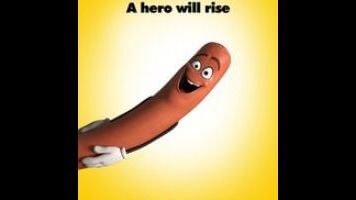
It would be easy and accurate to describe Sausage Party as a parody of contemporary family-friendly animation, particularly of the Pixar-produced variety. It explores the secret life, unseen by humans, of seemingly inanimate objects; it sends its celebrity-voiced lead character on an epic journey that ends in an antic showdown; and in a further nod to Disney heritage, it opens with a song co-written by studio stalwart Alan Menken. Yet this vulgar cartoon from Seth Rogen and Evan Goldberg doesn’t limit itself to inserting “fuck”s (verbally and otherwise) into the alive-object narrative. Rogen and Goldberg start with spoofery and work their way into something bolder and stranger; it’s as if playing in the Pixar sandbox, or a reasonable approximation thereof, can’t help but inspire creativity.
Even during that first parodic song, the movie is plunging into strange waters. In an energetic, “Be Our Guest”-ish production number, the supermarket food sings in praise of the “gods” who will bring them to the “great beyond”—that is, the humans who will pluck them off the shelves, take them away from the supermarket and, unbeknownst to these trusting foodstuffs, consume them with abandon. Frank (voiced by Rogen), a sausage sporting Mickey Mouse gloves, is especially eager to reach the great beyond, where he’ll finally be unwrapped and united with his girlfriend Brenda (Kristen Wiig), a hot-dog bun. But when a jar of honey mustard (Danny McBride) returns to the shelves ranting and raving about the horrors waiting on the other side, Frank’s entire belief system is shaken. Shortly thereafter, Frank and Brenda are separated from their packaging and make their way through the vast supermarket aisles after hours, searching for answers. They’re also pursued by a literal douche, voiced by Nick Kroll with rasping, amped-up bro-screams that aren’t quite as hilarious as the filmmakers seem to think.
Though passages of Sausage Party are addled with fast cuts and saturation-point swearing that diminishes the poetry of a well-placed “fuck,” the movie keeps returning to the network of religion-like beliefs and ethnic stereotypes that make up this food world. Many of the jokes mix real-world references with ridiculous puns, including an ongoing jab at Israel/Palestine relations, as anthropomorphized by Lavash (David Krumholtz) and Sammy Bagel Jr. (Edward Norton, capably impersonating Woody Allen, not Sammy Davis). The movie ridicules both intense faith and, later, the impatience with which “enlightened” nonbelievers try to puncture that faith, and even attempts some bizarre, sometimes drug-fueled metaphysical explanations for why (most) humans can’t see the food characters come to life.
It’s obvious that this seeming goof of a project actually means something to Rogen and Goldberg. (They’re the clear auteurs at work here; directors Conrad Vernon and Greg Tiernan are refugees from DreamWorks and Thomas The Tank Engine, respectively.) Frank’s dawning realization that he should not limit himself to prescribed religious rules sort of reflects the way Rogen and Goldberg have spoken repeatedly about how they work better with the freedom of an R rating. At times, Sausage Party bears this out too clearly, with a heavy focus on exploiting its status as the rare adult-targeted American cartoon via drug jokes, sex jokes, and the occasional gorehound violence that’s been an on-and-off staple of Rogen’s work since Pineapple Express. Some of these jokes are very funny; the integration of bath salts (the drug kind, not the retail kind) into the movie is a particularly demented inspiration. But sometimes the movie’s visual gags are just vulgar for vulgarity’s sake. The fake food names, for example, sacrifice clever satire in favor of a bunch of sex puns that barely qualify as puns. (Nothing in a grocery store would be called Butt Butter, and the joke isn’t funny enough to justify the laziness.)
This makes Sausage Party seem more constructed and less fully felt than the very best from this group of comedians; it’s not as soulful as Superbad, Pineapple, or even the similarly thoughtful This Is The End. Pixar, Disney, and other successful animation houses use their artistry to create near-instant empathy with what amount to cute drawings of bugs, fish, toys, and so on. Intentionally or not, Rogen and Goldberg use animation to create more of a distance between the characters and the audience. The cartoon food citizens of Sausage Party, while amusing to watch, don’t have the full warmth or good nature of the actors who voice them. A runty sausage voiced by Michael Cera is nearly as endearing as actual Michael Cera, but Rogen, Wiig, and Bill Hader, among others, feel a little more distanced even as they deliver funny vocal performances.
In some ways, that merciless quality makes for a purer distillation of the filmmakers’ sensibility, especially in their post-Apatow work. The last section of Sausage Party turns so trippily meta that it practically draws the exact line between brilliant invention and dude-what-if stoner ramblings. Rogen and Goldberg set out to spoof Disney cartoons and wound up ruminating on the mechanics of faith that allow audiences to believe in Disney cartoons in the first place. In the process, they may have reached a logical endpoint.